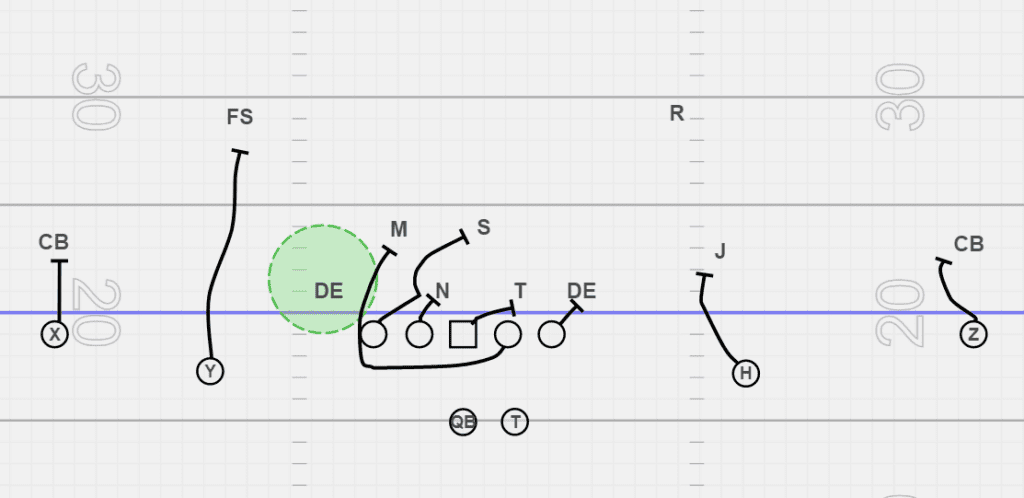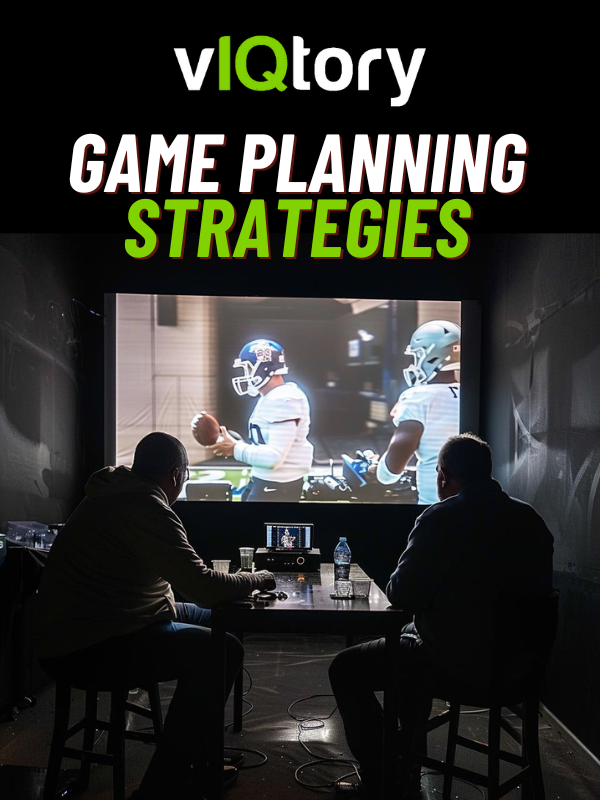The offensive line is one of the most critical positions in football. It requires a relentless and selfish attitude. The offensive line is also one of the most technical positions in football.
In this article, we’re going to show you how to play offensive line in football and how you can become the best offensive lineman on your team.
Offensive Line Position In Football
There are five offensive line positions in football: Left Tackle (LT), Left Guard (LG), Center (C), Right Guard (RG), and Right Tackle (RT). Their job is to block for the quarterback when he drops back to pass or block for the running backs.
The offensive line (also known as OL) works together as a unit to execute plays that the coach draws up. These players are typically the biggest (in weight and height) on the field.
Each offensive position is equally important, as they help protect the quarterback and the running from behind hit by a defensive player.
Below, we will teach you how to play offensive line in football and why offensive linemen are so important to every offense.
How To Play Offensive Line
The foundation of a good offensive lineman is his stance. Offensive linemen need to start in a power position to drive defensive players off the ball properly. Offensive linemen also need to establish the line of scrimmage, making sure nobody goes offsides when getting lined up.
To get in an athletic offensive line stance, first, make sure your feet are no less than shoulder-width apart.
Place your hands on your thighs, and slowly sink your hips back. When your hands start to go over the top of your kneecaps, stop. This is the optimal depth for a lineman in a 2-point stance.
The chest should be upright, and the player should move 360 degrees.
Unlike defensive linemen (whose main job is to move forward), the offense needs to move forward, side to side, and backward.
Because of all of these movements, the stance needs to be balanced.
When the ball is snapped, each step, hand position, and shoulder location matter for an offensive lineman.
If one of these three items is wrong, there’s a good chance the lineman will lose leverage and let the defensive player in the backfield.
How To Play Center (C)
A center is the quarterback of the offensive line. He is the player in charge of making all of the calls, blocking schemes, and helping his teammates on each play.
To be a great center, you have to be an intelligent player who takes pride in his craft.
The job of a center is to snap the ball and block defenders from getting at the quarterback.
You have to execute complex blocking schemes against the defensive line and help your other offensive linemen on every play.
The center has to be very quick and agile. A center should be able to snap the ball quickly to get the ball out before the defense has a chance to react.
When you’re a center, your job is also to help your other linemen communicate with each other on every play.
Your teammates should know where they need to block so that you can all open holes for your running back.
Learn How To Watch Film Properly…
Uncover your opponent’s offensive and defensive tendencies so you can easily build a game plan.
Inside You’ll Find:
- Strategies to pick apart defenses
- How to identify player weaknesses
- How to save time in your weekly breakdowns
How To Play Left Guard & Right Guard
A guard is a player in charge of blocking the defensive players directly lined up across from them.
For example, if you’re playing left guard, you have to block the defensive player who’s lined up directly across from you as well as the left & right side of you.
Guards also need to be able to block all different types of defenders.
Whether it’s a fast linebacker or a large nose tackle, you need to have good technique and stop them from getting at your quarterback.
How To Play Left Tackle & Right Tackle
The job of a tackle is to open holes for your running back and make sure that defenders don’t get in the backfield too quickly.
You have to be big and strong so that you can open up holes for your running backs and take on any defender that tries to get in your way.
Your job is also to protect your quarterback by blocking the defensive ends, often the defense’s fastest lineman.
A good tackle needs the strength to get his hands on any player on the defensive line while maintaining proper balance and footwork.
There is a difference between the right and left tackle. The left tackle is often the more talented tackle because they need to protect the quarterback’s blindside.
The right tackle is typically a bigger player who can effectively set the pocket for the quarterback’s throwing hand. If it’s a lefty quarterback, the opposite is true.
Offensive Line Blocking Types
Run blocking is one of the core techniques of playing the offensive line. It requires impeccable technique and the tenacity to move players on the defensive line out of the way.
Run blocking requires proper steps, hand placement, and shoulder placement.
There are three main types of blocks for an offensive lineman:
Down Block (Back Block)
The down block, otherwise known as a back block, is a 45-degree angle block.
This block is typically used when an offensive lineman pulls, and the offensive lineman needs to fill for them.
This block requires the offensive lineman to fire off at a 45-degree angle, put both hands on the defensive lineman’s shoulder and chest plate, and place the head across their body.
If the offensive player does this block correctly, the defensive lineman is pushed out and away from the play.
Base Block
Man on man, this block is a power block requiring an offensive lineman to block a defensive line straight up.
No angles are needed on this block, as the defensive player is lined up directly across from the offensive player. The goal is to get lower than the defensive lineman and remove him from the line of scrimmage.
This technique requires a wide base, hand placement underneath the shoulder pads of the defensive lineman, and strong exploding from the hips.
Pull Block
The last block is a pull block. This block is when the offensive lineman comes out of his stance, often running or skipping laterally, to block the offensive lineman.
The pull block is often to remove the defensive end from setting the edge of the defense.
This block requires precise timing and control as the offensive lineman moves toward the defensive end.
A skip pull is when the offensive lineman moves laterally to start, then moves upfield to block a linebacker. This is a common technique used in the offensive play “power.”

How To Pass Block In Football
Pass blocking is a technique used to prevent the defensive lineman from getting a sack on the quarterback.
This requires an offensive lineman to fire off the ball, using hand placement and foot quickness to stop a pass rusher from getting at the quarterback.
You need to be quick enough to get under their hands and beyond them to stop the defensive pass rushers.
You also need to control their moves by blocking them with your arms, sometimes with a shoulder or a hip.
To strike on a pass block, have your thumbs facing the sky, which perfectly fits on the opponent’s breastplate. Striking the breastplate allows you to grab it and control the offensive lineman.
Remember, it’s a penalty if you hold them while they try to move away from you.
If you keep the defensive player in front of you while your feet are moving with them, then it is perfectly legal.
Offensive Lineman Attitude
Offensive linemen need to be the most selfless people on the team. They don’t get stats and will hardly ever touch the ball.
However, they are very important to the offense in moving the football down the field. If one offensive lineman fails, there’s a good chance the play will be ruined.
While they will never be in the limelight, the offensive line plays a significant role in football. You should aspire to be like Quenton Nelson or Trent Brown if you’re young.
Keep Learning
Below are offensive lineman articles to help you learn even more. We’ve built the Offensive Line University course to help you master the position.
How To Snap A Football & The Different Types Of Snaps
Offensive Line Play: The Proper Stance
Why Offensive Lineman Wear Knee Braces & Elbow Sleeves
Who Protects The Quarterback In Football?
Playing the offensive line requires size, strength, and a selfless attitude. Offensive linemen don’t have individual stats, but their success is measured by the offense’s success as a whole.
If you want to learn more about the offensive line position, we recommend checking out our list of courses here.
If you want to learn more about football in general, we recommend you check out our learning center for more!


